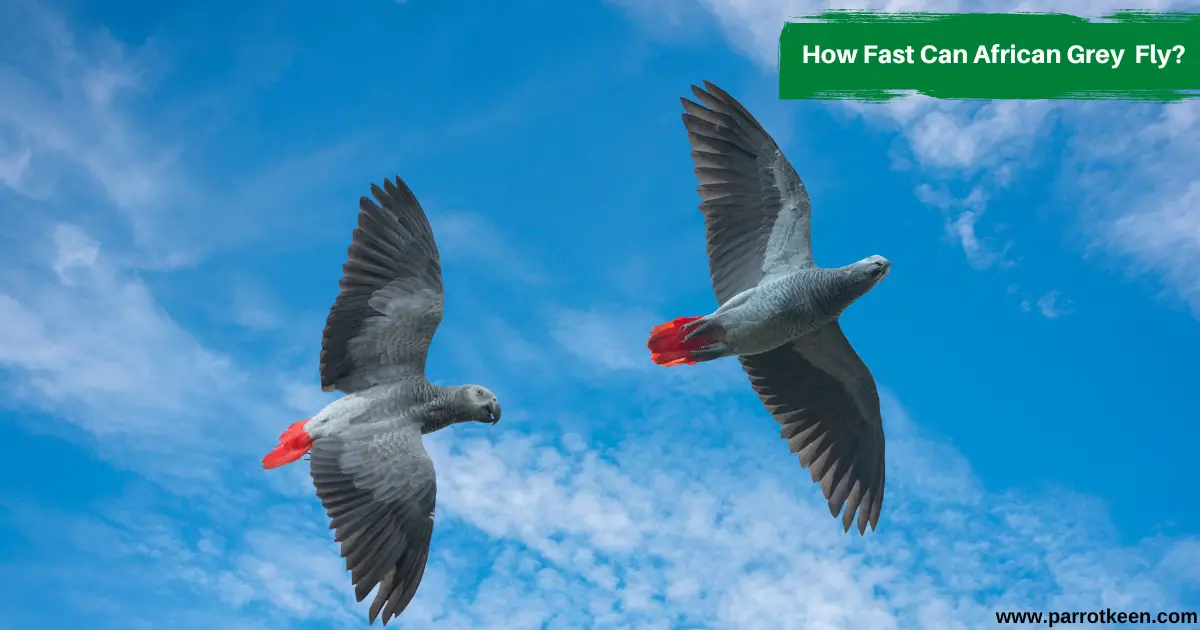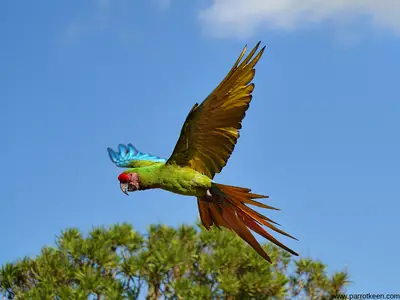![How Fast Can Parrots Fly[Quick Answer!]](https://parrotkeen.com/wp-content/uploads/2022/08/How-Fast-Can-Parrots-Fly.jpg)
How Fast Can Parrots Fly?
It is common knowledge that most parrots can fly by the time they are 2 months old, but this is not true for all of them, especially those that live in captivity and never get the opportunity to learn how to fly.
Flying hundreds of miles a day to find food, shelter, and a more pleasant temperature is standard procedure for wild parrots. In fact, birds like parrots are well-suited to long-distance flights.
Parrots have huge flight feathers and smaller secondary feathers, but only if their primary flight feathers are intact can they fly.
Parrots’ feathers, light bones, complicated respiratory systems, and four-chambered hearts enable them to fly at the highest possible efficiency.
Many parrots live and fly in big groups to avoid being eaten by predators. However, parrots rarely fly at night, preferring to sleep high in the trees.
But our focus in this guide is to know how fast can how far can a parrot flies, which we will be on right away!
Can All Parrots Fly?
Yes, all parrots can fly regardless of their size. The primary purpose of parrots’ use of flight is to avoid being caught by predators, search for food, and as part of their natural adaptive features.
How Fast Can Parrots Fly?

When it comes to flying, parrots’, size and breed make a noticeable difference in their speed. Parrotlets, lovebirds, and even budgies fly slower than larger types.
Those with larger wings and wingspans are more likely to be predators. The wingspan of macaws, for example, can reach 45 inches.
Because of this, parrots can fly at a maximum speed of 50 miles per hour, and that’s all they can do.
Unlike the Peregrine falcon, which can achieve speeds of up to 200 mph while descending steeply through the air, parrots are not fast flyers. Smaller parrots have been seen to fly at rates of up to forty miles per hour.
A low and slow flying position is used by parrots. They will, however, fly much faster if they are being pursued by a predatory bird.
No matter how large a parrot is, its flight speed is not influenced by its weight. The speed at which a parrot can fly is also influenced by its functional restrictions and evolutionary heritage.
How Fast Can A Scarlet Macaw Fly?
The scarlet macaw can fly for up to 56 kph (35 mph). As they fly they usually skim at the top of the forest canopy, this is because they try to avoid their predators which are large eagles and these eagles are generally adapted to make a kill in the open space.
This explains why scarlet macaws skim above the forest canopy while flying because they plan for an escape route from eagles when attacked.
Scarlet macaws do fly well among branches but eagles cannot. They need an open space to attack their prey.
How Fast Can African Grey Parrots Fly?
African greys typically fly at a speed of 45 mph, which falls precisely in the middle of the average parrot’s flight speed.
African greys are not notable but their flying abilities but for their talking ability. Also notable is their physical appearance which is soothing grey color and a bright red-colored tail.
This makes them a parrot of choice when most people are choosing a pet parrot. Furthermore, African grey parrots are notably one of the most intelligent parrots in the world making them a great option for pet birds.

How Fast Can A Parakeet Fly
Pet parakeets are known for being prone to exhaustion, yet they can travel up to a mile if they catch a wind current to ride. Parakeets are among the quietest and most docile parrot specie which makes them an option for most bird lovers.
They are not great at flying at high speed or for a very long time but they can be considered average when it comes to flying. They can go as fast as 30mph.
How Fast Can A Parrotlet Fly?
Many bird lovers keep parrotlets because they are very affectionate, and make great pets and companions.
Parrotlets can fly just like other parrots and they are fast when flying compared to kakapo. Parrotlets can go as fast as 50mph placing them above average when it comes to flying among parrot species.
How Fast Can A Quaker Parrot Fly?
Quaker parrots are good at flying, when they are younger they make a loud noise like a helicopter when they are flying. Quaker parrots can fly far and fast. They fly at an average of 45mph, this makes their flight rate average when it comes to flying in the parrot specie.
How Long Can Parrots Fly?
The species determines how far a parrot can fly. Greater-sized parrots are more likely to maintain a 1,500-3,000-acre flying radius. Foraging for food and water is made possible by the fact that they can stay close to their home zone.
However, parrots like macaws can easily fly 50-100 kilometers a day in search of food and shelter, especially during the dry seasons of the rainforest when food is scarce.
Smaller parrots, on the other hand, travel in big groups in search of food and water over a wide area.
A parrot’s career flight range is estimated to be up to 2 million miles, which is almost four trips around the moon and back.
These parrot species are thought to be able to travel the following distances at once:
- Orange-bellied parrots can fly up to 150 miles (240 kilometers) nonstop.
- Amazon parrots, cockatiels, and other birds: 10 kilometers a day.
- Cape parrots travel between 10 and 20 kilometers each day.
- 100-kilometer flight range for thick-billed parrots
- Birds migrating to warmer climates have a tendency to fly farther and faster than those not migrating.
How Far Can Parrots Fly?
Orange-bellied Parrots, which can fly 150 miles in a single flight, are the longest-distance flying parrots. Hold on to this. Two times a year, they travel to Tasmania from mainland Australia.
They’ve covered about 300 miles, but they’ve stopped on King Island, which is about halfway through the journey. They arrive at their destination after a few days of travel.
Another notable example is a nonstop flight of 100 kilometers by researchers tracking the rapid flight of Thick-billed Parrots, as well as a daylong flight of 320 kilometers by spring migrants. With Thick-billed parrots, however, this is not always the case.
Non-migratory large parrots, such as African greys, amazons, macaws, and cockatoos, fly more miles per day than smaller parrots.
At 50 miles per day, they’re capable of flying. However, they must stop for a short break every 10-15 kilometers. A hundred miles distant from where they started, they’d likely fly if they couldn’t find anything to eat.
Compared to larger parrots, little parrots can only fly 15 miles each day.
How Far Can A Parrot Fly In One Day?
Because parrots can fly up to 30 miles a day, so it’s not unusual for them to find a long way from home. Because of this, it is more difficult for your parrot to return home if they are a long distance away.
If you have a cage outside, you can help them by putting it there.
Can Parrots Fly Well?
A bird’s body is perfectly suited for flight. The vast majority of birds can easily perform complex aerial feats.
Parrots, on the other hand, can fly, glide, and do a variety of other things. In terms of flying ability, African greys aren’t among the greatest, but they’re not the worst either. Macaws and cockatoos are both birds.
Smaller parrots can achieve more advanced flying skills.
Parrots can also climb, and they do it regularly in their natural surroundings.
Rather than flying from one branch to the next, parrots use their beaks and sharp claws to climb to the next branch that contains more food or the branch where they placed their eggs, whichever is the case.
Do Parrots Enjoy Flying?
It’s like asking if we enjoy walking and getting a different answer from each person. Some people enjoy walking, while others prefer to sit on the couch and watch television or converse with friends.
However, for parrots, the flight is a natural instinct. These creatures have wings; they are able to fly as part of their nature. However, do they enjoy flying?
Depending on their situation, the answer is either yes or no. For example, wild parrots have the freedom to fly anytime they want, but if you know anything about parrots, you know that they don’t particularly appreciate the experience of flight. As a result, they’ll have a bird’s-eye view of the forest.
Imagine a parrot that is able to fly (it has learned how to fly) spending all of his time in his cage without any interaction or companionship.
Well, that’s a no-brainer. Of course, he’ll enjoy soaring over the sky and flexing his muscles.
Additionally, parrots need to be able to fly. To find food, mate, or a suitable tree to rear their young, they must fly. It’s not just birds who need to fly, even parrots.
What Is the Maximum Elevation of A Parrot’s Flight?
The flightless Kakapo parrot is the only member of the parrot family that is unable to fly, having lost his capacity to fly thousands of years ago.
But unlike the highest-flying bird, the Ruppell’s griffon vulture, which can soar to a height of 37.000 feet. This height is beyond the grasp of parrots.
That’s because of two main factors.
- Parrots do not emigrate from one region to another.
- Bar-headed geese, for example, soar as high as 28.000 feet during migration.
- Flying high increases the risk of being preyed upon by hawks, eagles, and other aerial predators who often fly high to strengthen their eyesight while searching for food.
Because parrots aren’t preyed on, they don’t need to soar at such altitudes in search of prey. For the most part, what parrots consume may be found in trees or on the ground, Because of this, parrots don’t need to soar so high in the sky.
Are Parrots Capable Of Such Feats?
There is no way parrots, like Ruppell’s griffon vulture or the bar-headed goose, can soar to the heights that these birds can.
As a result, how high can parrots soar? In most cases, parrots fly at a low altitude of 1000 to 3000 feet, unless they are on a long-distance migration. They can soar up to a height of 8,000 feet or more.
Not all parrots, on the other hand, migrate. The orange-bellied, blue-winged, and quick parrots are among the rare migratory parrots.
Since parrots are not a migratory species and there are numerous parrot breeds, no one has attempted to measure the maximum height that a parrot can fly.
Although they are not migratory, Corella parrots are the highest-flying parrots because they can soar in large flocks of up to 10,000 feet in the air. Australian natives fly from the grasslands to the forest trees in search of food at this altitude.
Conclusion: How Fast Can Parrots Fly?
It’s tough to know the answers because there are so many different parrot breeds to consider, and each one needs its own study to get the full picture.
As an illustration of this, an airplane at 37,500 feet altitude was struck by a Rappell griffon vulture and the resulting height was calculated.
Because of this, we can state that Rappell’s flying height was actually chosen by chance, and we want to find out more in the future.
Parrots’ flying speed and range are also comparable to that of birds of prey. These questions have yet to be definitively addressed by research. And that’s all there is to it.
Hopefully, this article will help you learn something new and interesting.
